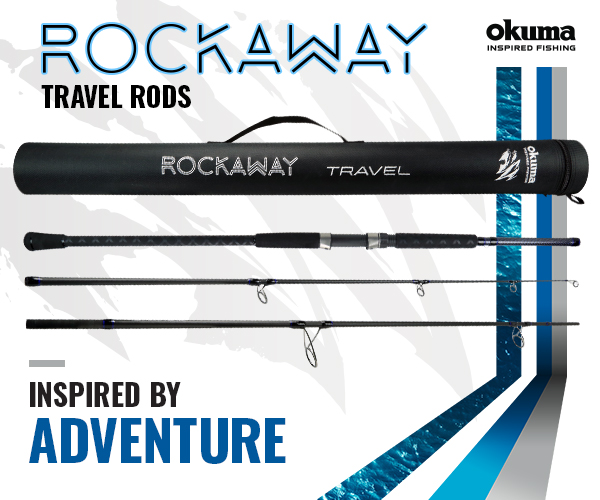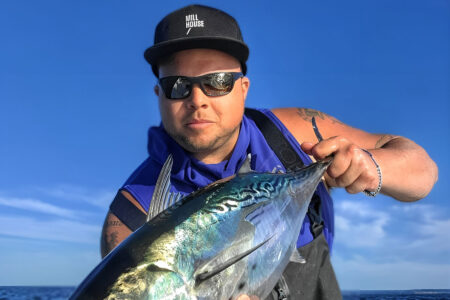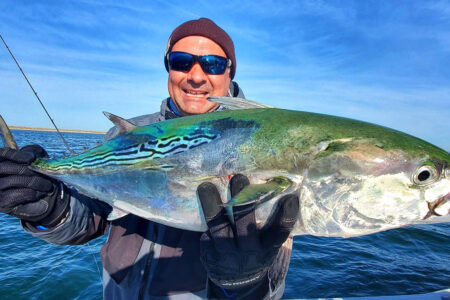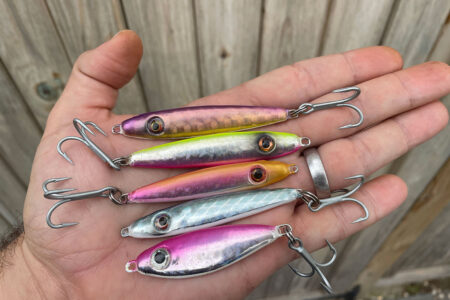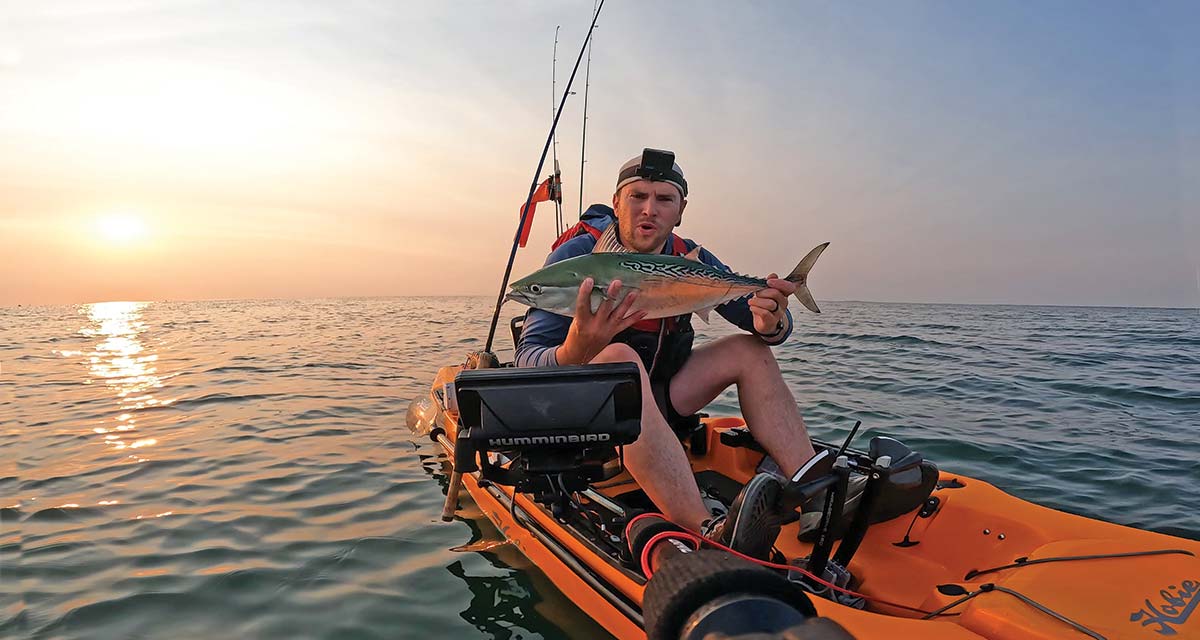
A kayak just might be the perfect platform for the albie hunter.
Kayaks may just be the best platform available to fish for false albacore (albies) here in the northeast. While certainly not be the fastest ride in the ocean, kayaks make up for their lack of speed with stealth. There is something about being right on the waterline when a blitzing school of albies rolls through that makes the experience surreal. Just seeing these beautiful fish interact with their environment is a treat. And we all know what a roaring engine tends to do to a boiling school of false albacore!
Your Platform
Albies are a species of small tuna and they can swim very fast. The platform you fish from can be a determining factor in how you fish for them. Albies boast a top speed of 40 mph, there is no kayak that is going to outrun one of these speedsters, but even so, a faster kayak is probably a good choice. A longer, narrower kayak is going to be significantly faster than a wider kayak. Many kayak albie anglers swear by the Hobie Revolution mirage drive kayak due to its superior speed and stability for how narrow it is. I have seen videos of this kayak going over 8 mph using the stock pedal drive system. When chasing down albies on the feed, that speed can make a huge difference.
I run a Hobie Outback during the Albie season. When needed, I can do short bursts of 5 knots. I choose to fish the Outback for its stability; 34 inches wide versus the Revolution at 28.5 inches. Remember, the wider the kayak, the slower it will be, so plan accordingly. The weather during albie season can get a bit sporty as it occurs during hurricane season so stability for me is something a put ahead of speed.
Pedal drive kayaks are important for the way I fish for albies. I like the hands-free aspect of pedal drive kayaks, not just for going fast, but also for the ability to stem the tide and hold in a stationary position while waiting for a school to pop up. Of course having your hands free to cast and fish is another, obvious, perk. Albies are fast, sometimes up and down so fast that you may be lucky to get one cast off before they disappear. Having the rod in hand ready to cast will result in a higher number of chances to hook up.
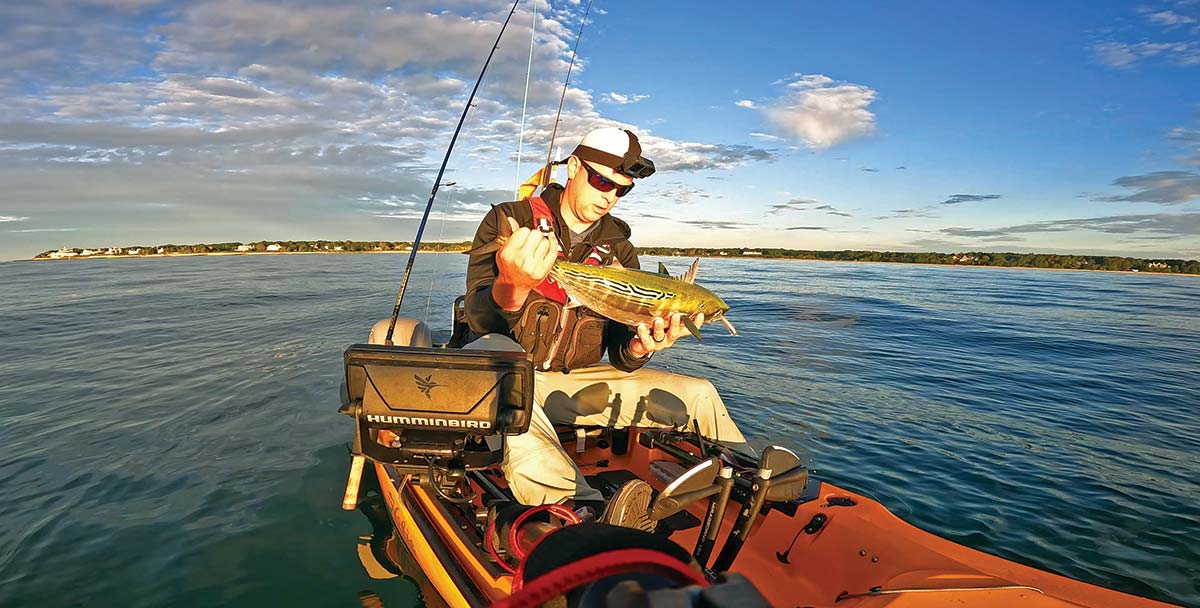
Pack Light
The best advice I can offer for targeting albies from the yak is to leave your excess gear in the car. I am a guy who wants to make sure I have every scenario I could come across on the water covered, but when it comes to albies, I pack light. Outside of safety gear and my fish finder, I bring two rods and a small tackle box with my albie lures in them. Absolutely no cooler (I don’t keep albies), crate or other accessories.
Why so light? Speed and accessibility. With the albies being so fast, I want to make my attempts to catch them easier. It takes more energy to move a kayak that is weighed down with a bunch of extra gear. Your pick up will be slower and let’s not forget launching it. Moving a kayak across sand to launch isn’t the easiest thing to do, nor fun. With added weight, you will be exhausted before you even hit the water.
Chances are if you have ever seen an albie feed, you have seen bait spraying and albies hot on their tails. This usually helps you figure out what you need to throw at them. I am a match the hatch kind of guy when it comes to albies but there are crazy color schemes out there like Electric Chicken that albies eat with reckless abandon. My favorite bait is a white 3/4-ounce Exo Jig made by Game On Lures. These jigs are compact yet heavy, they cast a mile and their profile in the water appears smaller due to their thick epoxy coating. These work well when albies get picky eating the small bay anchovies.
High Probability Locations
While the areas I am going to talk about are places I focus on primarily, it is good to remember that albies can and will pop up anywhere. Although a pelagic species, which you would think would prefer deeper water, I frequently find albies in depths of five feet or even shallower. This past year, I had an incredibly slow day of albie fishing where the fish just never showed on the surface. On the way back to the launch I was traveling up a shallow salt pond when I was flagged down by a commercial quahogger. He was nice enough to tip me off that he had seen albies going crazy all morning inside the pond. Nobody fished them and they were left to gorge on the glut of peanut bunker this area had, uninterrupted! Another day after this, I went into the pond to check to see if they made it inside, sure enough, I soon found albies to chase when there weren’t any outside the inlet!
One thing I find in all the places that I fish for albies are that they are rich in baitfish. Bait is the building block of life for all predatory fish and it is a necessity if you want surface busting albies to chase. Come fall, most inlets will be covered up in bait. Thick clouds of rain bait, bay anchovies, silversides, peanut bunker pour out of inlets and salt ponds into open water, drawing in schools of albies. These places are usually very accessible to kayak anglers, and easily within range of calm beach launches inside the inlet. A word of caution. Watch your wind and weather very carefully here, the current can rip through outflows especially on an outgoing tide. If you couple this tide with a with offshore hurricane groundswell, you can have very dangerous conditions. If possible, take a look at the inlet before you drop the kayak in the water, you really don’t want to find yourself in a dangerous or life threatening situation. Many times, albies run the jetties of these inlets as well, trapping bait against the rocks and the conditions will need to be just right if you’re going to fish that situation from a kayak.
Current seams are another place that I focus on when albie fishing. Albies are intelligent fish that know how to use current to their advantage. Schools of bait can get disoriented within these current lines offering the albies an easy meal. Tide lines don’t always appear in the same spot so finding these can be a challenge. If you do manage to come across one of these though, it’s definitely worth hanging around for a little bit and casting at it. Especially if you aren’t seeing much surface action, albies just may be lurking in the current and not showing on top.
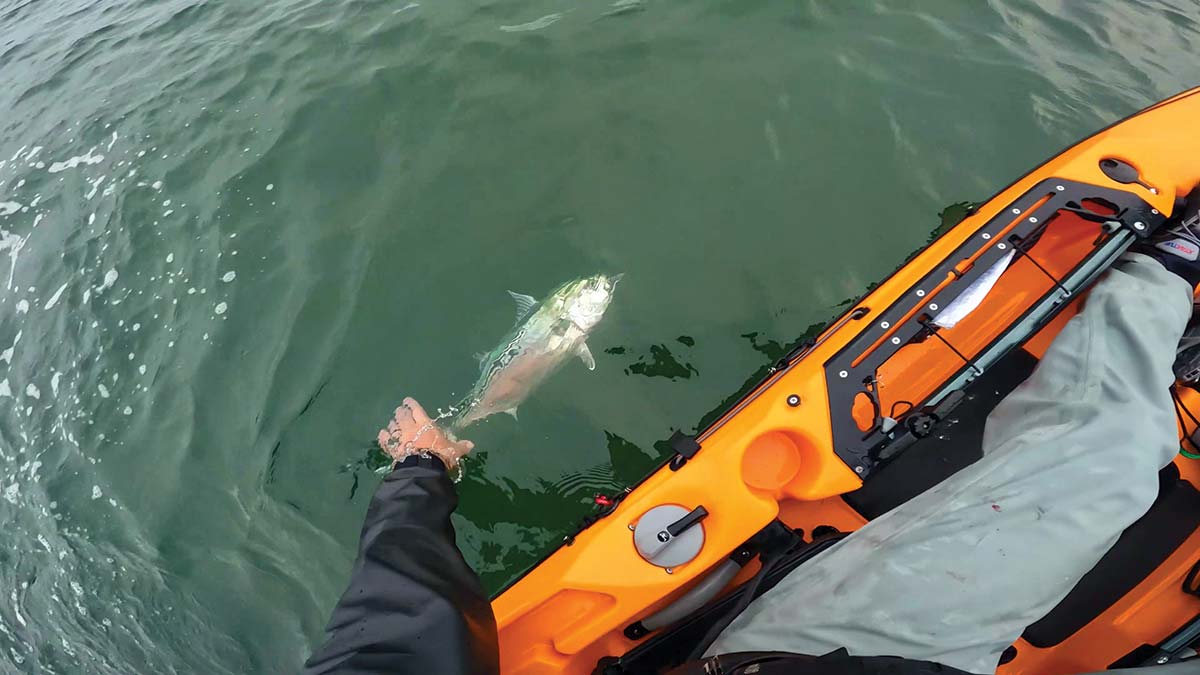
Hurry Up Or Wait?
There are two ways that I target kayak albies, both of which have proven successful for me in the past and they couldn’t be more different; ‘running and gunning’ and ‘sitting and waiting’! These methods have their own times and places. Running and gunning is basically chasing actively feeding surface schools of albies and hoping to get a cast into them before the feed is over or other boats (or yourself!) put them down. Faster kayaks have a distinct edge here as the first person on the feed usually has the best chance of hooking up. This technique is extremely effective when you find your own isolated school and you have more time to reach the school without interference or getting cut off by other fishermen. This isn’t a common thing as a kayaker but it does happen! While this method can be exhausting or even stressful at times, it is very effective, I probably catch 75% percent of my albies this way.
Sitting and waiting is very effective when the boat traffic and crowds are all running around like chickens with their heads cut off and putting down the fish before you can get to them. This is common on the weekends and holidays when it just seems like nobody has a job anymore. This tends to be more effective during these busy days as the fleet that’s fighting over the fleeing school of albies will keep drifting down the beach as the bait that attracted the original school regroups. Many times that school of bait will incite another feed, but this time you will be in place to get a cast in soon after the feed resumes. When you slow down, you can decipher patterns in the area such as favored bait hangouts or spots that the albies continually come up or even an overall rhythm to how the albies are using the area to corral and ambush bait. These are things you likely wouldn’t notice if you were running and gunning. Plus, there is something extra satisfying about hooking up when the rest of the fleet has run off chasing their tails and you just happened to be in the right spot!
One of my favorite ‘sit and wait’ techniques is finding an isolated bait school and just staying with it. This is easier on sunny days as the dark coloration of the school will stand out in contrast to the water making it easier to follow. Once I find this, I stay with the school for a minimum of 10 minutes. Now I just cast into the school and reel out of it, trying to sell my jig as a rogue baitfish leaving the pack. This technique has worked on albies that never made any push to the surface as well as a bonus Spanish mackerel or two. People get too focused on the surface melees and the excitement that they bring and look right past some of the most textbook fishing opportunities that swim by them.
If there is one thing to take away from this article is that small adjustments to the fine details will result in more fish. Something as simple as slowing down can make a trip. Everyone has their own way of fishing for albies, and that’s okay. Hopefully you take away something here that will improve how you fish for the most exciting inshore species the Northeast has to offer!
